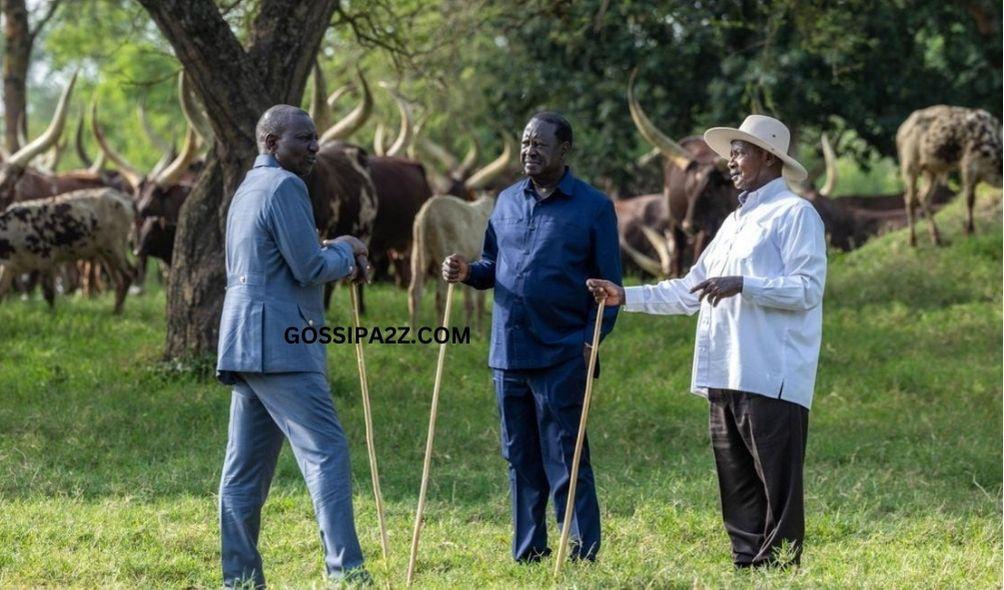Museveni ‘Handshake’ With Ruto Expected to End DRC Conflict, Oil Import Dispute
The recent gathering between President William Ruto and his Ugandan counterpart Yoweri Museveni shouldn’t have attracted much attention. After all, they have been political allies for some time.
However, their recent actions diverged from their previous agreement, following Uganda’s decision to pursue an alternative oil import plan and initiate legal action against Kenya in the East African Court of Justice (EACJ). This week, driven by his priorities, President Ruto journeyed to Kisozi in western Uganda to confer with President Museveni.
During the gathering, Raila Odinga, the opposition leader of Kenya, whom Nairobi supports for the position of the next African Union Commission chairperson, was also present. He has been actively seeking votes from neighboring countries like Uganda. The precise organizers of the meeting remain uncertain, though credible sources informed Gossipa2z.com that both President Ruto and Mr. Odinga expressed a desire to meet with the Ugandan leader.
According to reports, the original aim was to address the oil import disagreement, with Mr. Odinga expected to act as a mediator. Subsequently, discussions were planned regarding the conflict in the Democratic Republic of Congo, and finally, there was a proposal to endorse Mr. Odinga as a candidate for the AUC position, seeking Uganda’s support to unite a fractured East African Community (EAC).
President Museveni released a statement indicating that they deliberated on topics of shared advantage and the overall state of affairs within the East African Community (EAC).
“I was happy to meet President Ruto and Rt Hon Odinga this afternoon at my farm in Kisozi. We discussed issues of mutual interest between our two countries and the East African Community,” he said. But President Ruto went further, indicating there is a path now to resolving the oil import dispute.
“We have agreed on a way forward of sourcing and scheduling imports for the region in a manner that will ensure we achieve the most competitive pricing and maximum logistical efficiency,” President Ruto said.
One potential solution to the deadlock involves providing Uganda with specific privileges to independently import and schedule its products. According to a source, this could involve the registration of the Uganda National Oil Company (UNOC) in Kenya, marking a departure from Nairobi’s previous stance when Uganda initially requested to function as an oil marketer in Kenya. However, Nairobi’s conditions stipulate that Uganda must first withdraw its case at the East African Court of Justice (EACJ).
President Museveni had contacted Tanzania to utilize its Dar es Salaam and Tanga ports for importing petroleum products, aiming to counteract oil cartels in Kenya. However, if the importation dispute in Kenya is resolved, the shorter distance there would be a preferable option. Although it appears that President Museveni is making progress in Nairobi, he is not completely abandoning the agreement with Tanzania.
ALSO READ:
- “Two Groups, One Agenda”: Gachagua Accuses Raila of Secret Political Deals
- Exclusive: Ida Odinga’s 75th Birthday Party in Karen (Photos)
- FKF President Discloses Exact Amount Paid to Harambee Stars Players
- Gachagua’s Ally Senator John Methu Admits Ruto Might Win 2027 Elections
- Maraga Explains Why He Hasn’t Campaigned in Kisii Despite 2027 Bid
Kenya’s Minister of Energy, Davis Chirchir, and the Principal Secretary of the Treasury, Chris Kiptoo, who were also present in Uganda, refrained from providing any remarks on the issue.
Regarding the conflict in the DRC, President Museveni promised to support and ensure the success of the Nairobi Process initiated by former President Uhuru Kenyatta.
On September 13, 2022, during his inauguration, President Ruto appointed Mr. Kenyatta as a peace envoy to the Great Lakes Region, which somewhat acknowledges his current position as the Facilitator in the Nairobi Process on the Democratic Republic of Congo within the East African Community.
President Ruto and Mr. Kenyatta, despite their local political disagreements, have never convened to assess progress, rendering the Nairobi Process inactive. Sources close to Mr. Kenyatta attribute the stagnation of peace efforts to President Ruto’s overshadowing of his predecessor’s mediation. Allegedly, Mr. Kenyatta has expressed frustration over perceived hindrances during his travels, including inadequate support both in Nairobi and at the EAC secretariat.
“Our cohesiveness had been lost on the matter and our military in the DRC looked ridiculous because we lacked the political leadership necessary,” said a diplomat familiar with the Process. “Uhuru was left high and dry but was lucky, sort of, because other leaders wanted him to succeed in the DRC and they still want him to succeed.”
The gathering in Kisozi might have represented a pivotal turning point for President Ruto, akin to his moment of realization or transformation. However, it also brought President Museveni back into the fold. Initially hesitant, the seasoned leader declined participation, believing that the process required direct political backing from Nairobi. Following the meeting, President Ruto alluded to a desire to foster harmony across the entire East African Community (EAC) to advance its integration objectives.
“Kenya and Uganda are committed to deepening the long-established diplomatic and economic ties between our two countries. This relationship includes bringing all the seven East African Community nations closer in their ultimate goal to form the East African Political Federation,” President Ruto said.
Museveni ‘Handshake’ With Ruto Expected to End DRC Conflict, Oil Import Dispute
